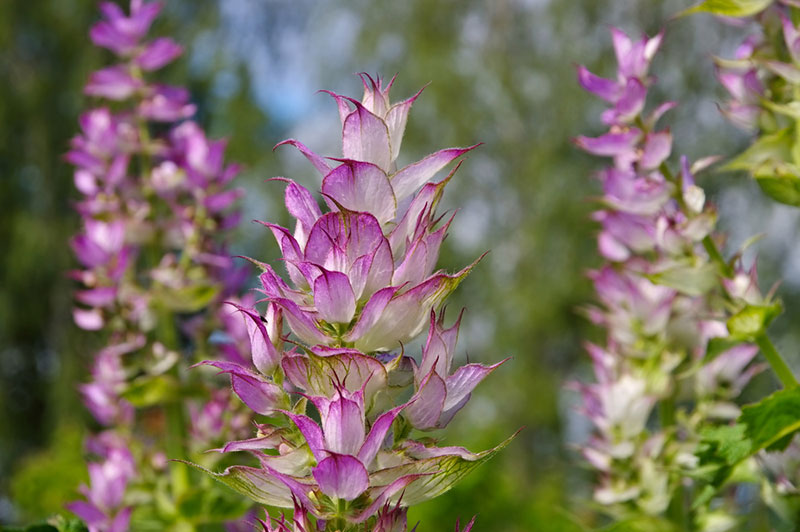
Once a staple of old-school kitchen herb gardens, Clary Sage is a member of the mint family and is primarily grown for its medicinal properties. This herb can also be used as a seasoning in soups, stews, and stuffing in the same way you’d use ordinary garden sage. It’s also grown for its essential oils, which are used in the production of soaps, personal fragrances, and even as flavorings in wines and liqueurs.
Clary Sage grows primarily as a biennial but sometimes performs as a short-lived perennial when conditions are right. However, performance is usually poor if the plant lingers beyond two years, so most gardeners choose to remove it in autumn of its second year. It provides an attractive floral display during the plant’s second summer with spires of white, lavender, or pink flowers rising above gray-green leaves. Because the flowers are fragrant, place them near a window if possible to enjoy their scent on summer breezes.
Here’s what you need to know about growing Clary Sage in your home garden:
How to Plant Clary Sage
Although it isn’t fussy about soil as long as it’s well-drained, Clary Sage needs to be planted in full sun to perform its best. It can also be started indoors 8-10 weeks before the last frost and transplanted to the garden. Space Clary Sage at least two feet apart to ensure plenty of room to grow — this herb can grow to four feet tall in optimal conditions. Clary Sage normally doesn’t need staking, but be sure to pinch them back if the plants become leggy.
Like all herbaceous perennials, Clary Sage can be grown in containers on decks, patios, and balconies provided the plants receive at least six hours of direct sunlight per day.
Water, Soil, and Temperature Requirements
As mentioned, Clary Sage grows in all soil types as long as good drainage is part of the picture. Heavy clay soils should be amended with organic compost and sand to improve aeration. As a native of the northern Mediterranean Basin, Clary Sage only requires average summer watering to thrive, although extra water should be provided if leaves begin to wilt during periods of drought. Always allow the soil to dry between waterings because Clary Sage is susceptible to root rot in overly damp conditions.
Clary Sage can withstand hot summer temperatures, and because they enter dormancy in late autumn, they can survive cold winters down to USDA zone 5 as long as gardeners add a layer of mulch after the plants die back for the season.
Pests and Pathogens
Like other aromatic herbs, Clary Sage is highly resistant to pests and pathogens as long as the plants are healthy. Common garden pests such as thrips, aphids, and whitefly can be controlled through applications of insecticidal soap on an as-needed basis. Caterpillars can become an issue with Clary Sage, but gardeners can limit the damage they cause by introducing natural predators such as ladybugs to the herb garden.
Powdery mildew and other fungal pathogens can be discouraged by keeping foliage dry and watering early in the morning so that excess water has the chance to evaporate before dark. There should be ample space between plants to allow for good air circulation, and weeds should be removed to minimize pest and pathogen habitat.
Fertilizing Clary Sage
Overfeeding causes Clary Sage to weaken and languish, so feed the plants lightly — if at all. It’s best to skip the fertilizer in nutrient-rich soil.
Propagating Clary Sage
Because Clary Sage mainly performs as a biennial, be sure to leave some seed in autumn so that it can self-sow in your herb garden. Clary Sage can also be propagated by cuttings as well as a process known as layering, which involves making a small cut in the stem tissue of a mature plant before affixing the stem underground in the soil with a U-shaped pin designed for this purpose until the stem begins to form its own root system.
Most home gardeners prefer to either grow Clary Sage from seed or purchase nursery starts. Sow seeds directly into the soil where they are to grow, or start them indoors on a sunny windowsill 8-10 weeks before the last frost.





